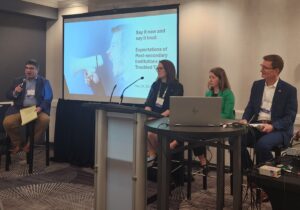Trends and practices in higher ed marketing and communications: conference recap
By Ruba Hassan and Sharon Aschaiek | July 24, 2024

The 8th Annual Marketing & Communications for Post Secondary Conference buzzed with innovative and practical marcomm approaches that universities and colleges are using to promote their institutions, engage with stakeholders and navigate contemporary crises.
Taking place May 27 to 29 in Toronto, the event, which was organized by Renee Summers of SummersDirect Conference & Events and Andrea Tubbs of Swansea Communications, featured engaging presentations and interactive sessions led by universities, colleges and marcomm firms across the country. Here are some highlights of the topics that were covered and the insights that emerged.
Amplifying DEI in marcomm work
From the University of British Columbia, participants learned how the university is advancing diversity, equity and inclusion (DEI) in its marketing and communications work.
Cindy Connor, content and digital marketing manager, explained how UBC developed a new framework to increase DEI education for staff that involved creating guidelines on inclusive language and respectful image use. They also engaged outside experts to train on inclusive communications, and used employees’ DEI-related knowledge to host internal workshops. She said the goal is to ensure content is respectful and avoids tokenism.
“This is ongoing work, a chance for our communicators to share their expertise,” says Connor, who presented with Carolyn Ali, senior content strategist and writer. “People are afraid they’ll get it wrong, but you can’t get it wrong if you don’t try.”
The role of the CCO
Another engaging session from Sheridan College looked at the role, competencies and challenges of the chief communications officer (CCO) in higher ed.
Nicolle Wahl, chief communications and marketing officer, explained how the CCO focuses on long-term reputation management, brand awareness and stakeholder relationship management. She noted that being a good listener is a crucial skill for the CCO. The CCO needs a “spidey sense” for both overt language and subtext, and must listen to stakeholder input whenever and wherever it arises.
Comparing the role to being an astronaut, Wahl explained how CCOs need an easy going temperament, must cope with stress well, and be able to create a culture of collaboration for their teams. One way to do this is to engineer what she called “positive collisions” to break down silos and enable productive conversations.
Finally, Wahl discussed how data analysis is increasingly becoming an essential skill for the CCO. She shared how data helps her understand the needs, preferences and behaviours of stakeholders while acting as an early warning system for potential problems.
AI for content creation
Also presenting at the conference was Ryan Patterson, multimedia video producer at Humber College. He shared about useful AI applications for media production such as Midjourney, an image generator, and Runway and Sora, software that can generate short videos based on prompts.
For audio production, Patterson recommended udio to help find the perfect soundtrack for content. He demonstrated how tools like ElevenLabs and HeyGen can be used to translate and dub audio, which can save hours of work. He also shared how other AI tools can help with creating shorts from longer videos, turn articles into video content, and remove background noise from audio recordings.
Patterson ended by examining the ethics around the training of AI models and who owns the copyright to their output. He stressed the importance of disclosing AI use in higher ed marcomm work and putting policies in place to guide AI use.
The impact of geopolitics
In a panel session moderated by Andrew Leopold, associate vice-president of marketing and communications at Humber College, three Ontario college marcomm leaders discussed the growing expectations of higher ed institutions to address geopolitical issues, and their responsibility to be voices of their communities in troubled times.
While all the panelists noted the growing expectation of post-secondary institutions to take a stand on issues affecting their community, they also underscored the challenge of deciding which issues to comment on and when to stay silent. Emily Milic, associate director of communications at Humber, shared that her institution saw a decrease in engagement the more they commented on social issues. To mitigate this, her team decided to comment only on issues that directly impacted their community, and when it planned to do something to address them.
“We are a social justice-concerned organization, not a social justice organization, and we need to keep making that distinction,” Milic said.
Lindsay Holley, director of communications at Durham College, shared a case study on how the school decided to deal with public outrage surrounding a transgender speaker being invited to its National Day of Remembrance and Action on Violence Against Women event in 2022. She described how the speaker’s announcement on social media sparked transphobic comments. Holley’s team investigated and found that most of the backlash did not stem from the college community, so they chose to ignore it and go ahead with the event.
Bill Steinburg, senior media relations and communications advisor at Mohawk College, also shared a case study from 2019, when the school’s McIntyre Performing Arts Centre was booked by a controversial politician for a fundraising event, which resulted in public protests. He explained that the institution made sure to separate itself from the event and make clear that its policy of renting the space did not equal an endorsement.
“We’re part of the breath of the community and city that we’re serving,” Steinburg said. “It’s our job to understand the sensitivity of the community and be able to sympathize.”